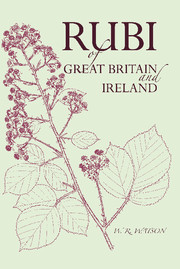Book contents
- Frontmatter
- Foreword
- Preface
- Contents
- INTRODUCTION
- I Environmental variations
- II Genetic intraspecific variations
- III Chromosomes and genes
- IV Reproduction
- V The species in Rubus
- VI Ecesis and migration
- VII Enemies, pests and diseases
- VIII Classification
- IX Collection and identification
- X Characteristics of the British-Irish bramble flora
- XI Cultivating native blackberries for fruit
- XII Note on the nomenclatural type species for the genus Rubus and subgenus Rubus
- XIII Key to the vice-county numbers
- XIV Signs and abbreviations
- ARRANGEMENT OF THE GENUS RUBUS LINN. IN AN ANALYTICAL KEY
- DESCRIPTIONS
- DRAWINGS
- Glossary
- Principal works consulted
- Index
VI - Ecesis and migration
Published online by Cambridge University Press: 05 June 2016
- Frontmatter
- Foreword
- Preface
- Contents
- INTRODUCTION
- I Environmental variations
- II Genetic intraspecific variations
- III Chromosomes and genes
- IV Reproduction
- V The species in Rubus
- VI Ecesis and migration
- VII Enemies, pests and diseases
- VIII Classification
- IX Collection and identification
- X Characteristics of the British-Irish bramble flora
- XI Cultivating native blackberries for fruit
- XII Note on the nomenclatural type species for the genus Rubus and subgenus Rubus
- XIII Key to the vice-county numbers
- XIV Signs and abbreviations
- ARRANGEMENT OF THE GENUS RUBUS LINN. IN AN ANALYTICAL KEY
- DESCRIPTIONS
- DRAWINGS
- Glossary
- Principal works consulted
- Index
Summary
If sown when ripe, seeds of brambles germinate readily in open soil from soon after mid-March until June. This has been my invariable experience over more than 40 years, and it agrees fairly well with that of Babington who says that more than forty kinds sown at Cambridge in the autumn usually appeared in the succeeding May or June. Genevier, however, at Angers in the west of France says that in his experience the seeds are difficult of culture and take two years to germinate.
Seedlings are to be found in nature near blackberry bushes wherever birds perch, at the foot offences or hedges as well as on bare soil under the bushes themselves. They are recognized by the elliptical, ciliate seed-leaves. The seedlings will perish if they are too much exposed to the sunshine.
Species foreign to my neighbourhood which I have brought into my garden at Bickley I have subsequently met with near fences beside footpaths up to a distance of 200 yds. away, which gives an idea how far they may be transported by resident birds in autumn. The seeds are carried endozoically by birds that eat the berries, as the Turdidae, Magpie, Crow, Golden Oriole, mountain birds as Grouse, Blackcock, Ptarmigan, Capercaillie, and by mammals as Man, Bear, Fox and Pine Marten. They may be carried also epizoically overland by birds, especially by Woodcock, which, with wet mud on its legs after a night's feeding in marshy ground, repairs at dawn to crouch and doze under bramble bushes and hollies during the daytime. Woods called ‘ Woodcock Wood’ or ‘Cockshoot Wood’, or woods near them, especially on rather high ground, consequently often contain far-brought bramble species.
About 20 years ago a bush of R. glanduliger came up under a holly on Chislehurst Common at the highest point of the Tertiary plateau, where Woodcocks had been twice observed. Until then it was known only in west Sussex. As I used to pass the spot every week and had listed all the species, now 19, growing there on the green, I could be certain about its introduction.
- Type
- Chapter
- Information
- Handbook of the Rubi of Great Britain and Ireland , pp. 13 - 16Publisher: Cambridge University PressPrint publication year: 2013



